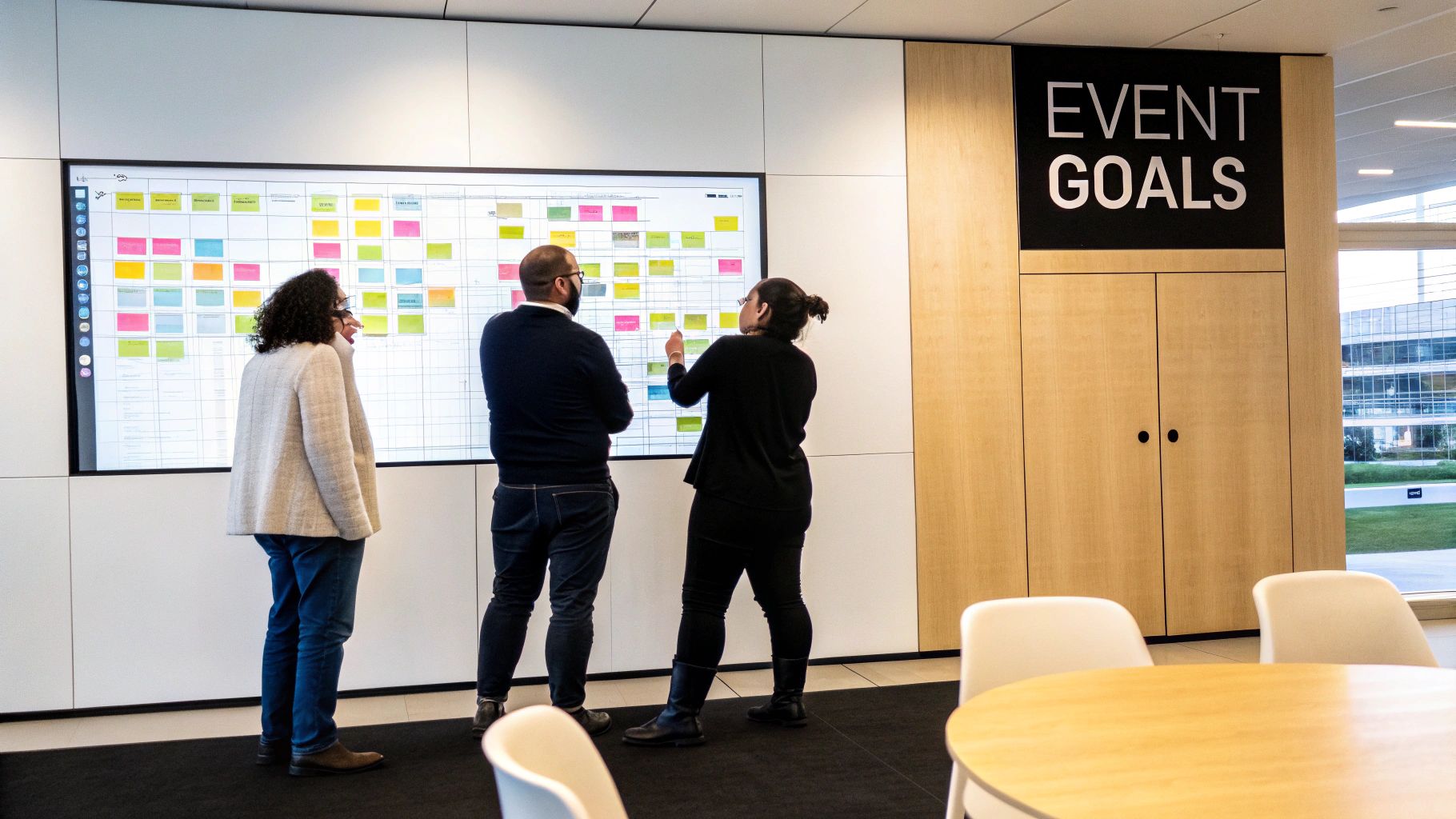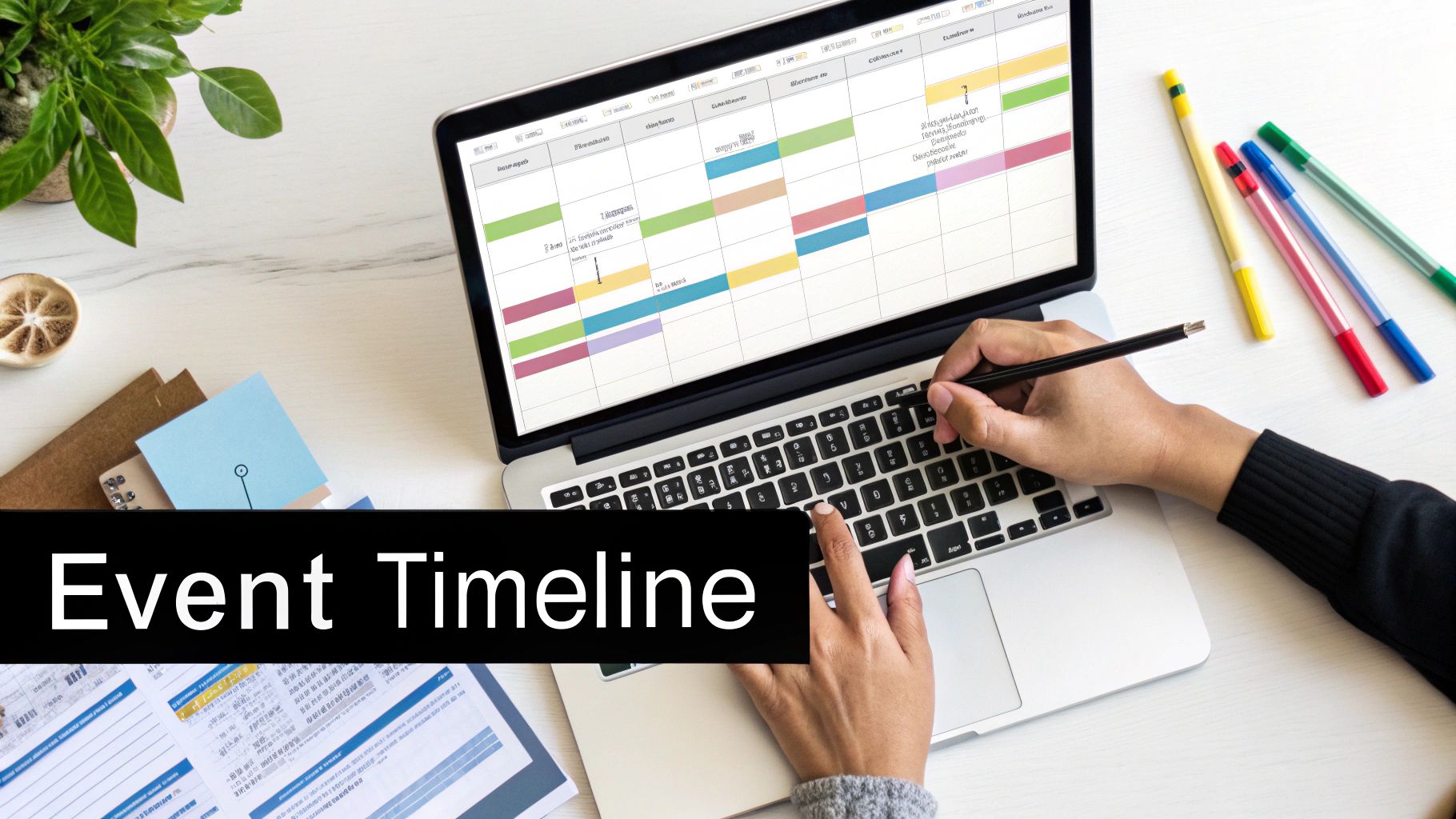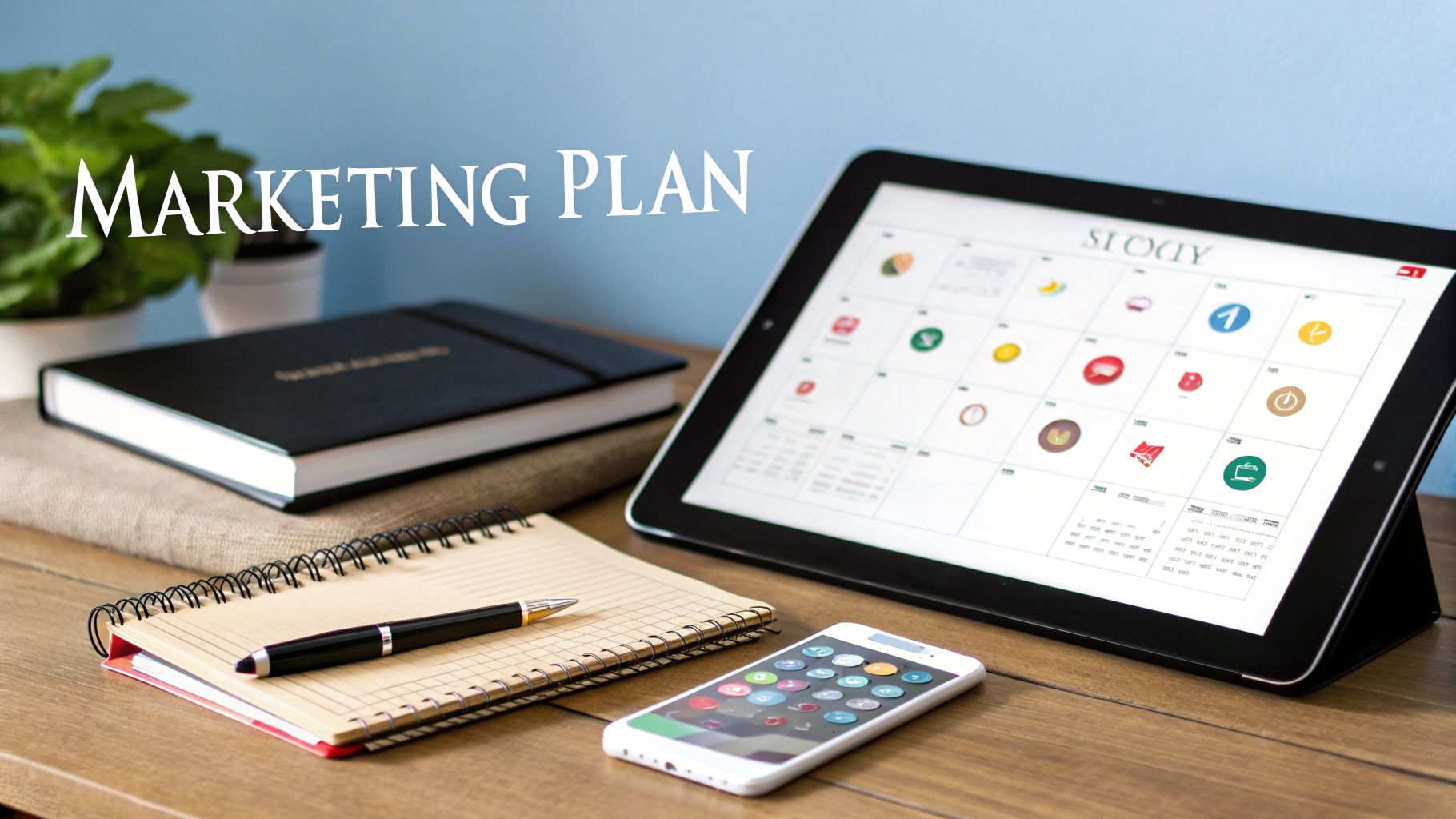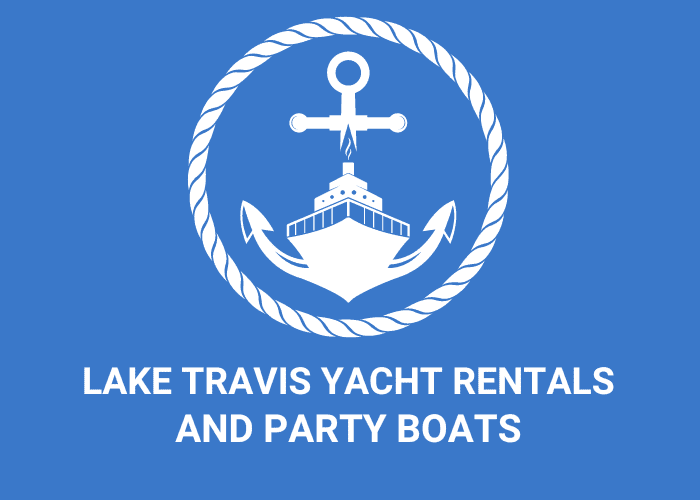Planning a corporate event often feels like navigating a minefield of spreadsheets, deadlines, and stakeholder expectations. But what if you could transform it from a daunting task into an exciting opportunity to create something truly unforgettable? This year, let's ditch the stuffy conference rooms and predictable agendas. Imagine your team celebrating a huge win, brainstorming innovative ideas, or building genuine camaraderie while cruising the stunning waters of Lake Travis.
This isn't just a fantasy; it's a completely achievable reality. Our comprehensive corporate event planning checklist is your secret weapon, your blueprint for flawless execution. We’ve broken down the entire process into 10 manageable, actionable steps designed to ensure no detail, big or small, is overlooked. This guide is built to help you craft an experience, not just another mandatory meeting on the calendar.
From defining goals that actually inspire your team to choosing a venue that truly wows (hint: a luxury party boat is an absolute game-changer), we will guide you through every single stage. Prepare to move beyond the boardroom and plan an event that your colleagues will be talking about for years to come. Why settle for a standard hotel ballroom when you can host an incredible event on the water? Our fleet is ready to make your next corporate gathering the highlight of the year. Let's dive in.
1. Define Event Objectives and Goals: The 'Why' Behind the Wow
Before you dive into venue scouting or catering menus, let’s hit pause and ask the most powerful question in your entire corporate event planning checklist: Why? This isn't just a philosophical exercise; it's the strategic foundation that separates a forgettable gathering from a landmark event that achieves real business results. Without a clear purpose, you're just planning a party. With a clear purpose, you’re architecting an experience designed to inspire, engage, and deliver measurable ROI.

This initial step is your North Star. Is your goal to generate qualified leads, celebrate your top sales team with an unforgettable incentive trip, or boost company morale with a unique team-building day? Each goal demands a different approach. For example, rewarding a high-performing team isn’t just about giving them a day off; it's about creating a "wow" moment that makes them feel truly valued. Imagine hosting that celebration on a luxurious yacht on Lake Travis, where the goal isn't just fun, but fostering loyalty and motivation against a stunning backdrop. That's an experience they'll talk about forever.
How to Set Powerful Objectives
Your goals need to be crystal clear and actionable. The best way to achieve this is by using the SMART framework:
- Specific: Instead of "improve morale," aim for "increase employee engagement scores by 15% in the post-event survey."
- Measurable: Define your KPIs. Will you track social media mentions, leads generated, or attendee feedback scores?
- Achievable: Be realistic. Can you truly host 500 people on your current budget, or is a more intimate, high-impact event for 50 a better goal?
- Relevant: Does the event directly support a larger business objective, like Q4 sales targets or talent retention?
- Time-bound: Set clear deadlines for your goals, such as "Generate 100 new MQLs within 30 days of the event."
By documenting these goals, you empower every stakeholder and vendor to work toward the same vision. This clarity is a core principle in any successful event strategy. To learn more about how defining objectives can elevate your planning, check out these insights on how to plan amazing corporate events. Defining your "why" ensures every dollar spent and every minute planned moves you closer to a spectacular, goal-crushing success.
2. Establish Budget and Financial Planning: The Blueprint for Success
Now that you’ve defined your "why," it’s time to tackle the "how much." Establishing a comprehensive budget isn't just about crunching numbers; it's about allocating resources strategically to bring your vision to life without any last-minute financial surprises. This is the blueprint that guides every decision you make. A well-managed budget is the bedrock of a smooth, stress-free, and successful corporate event planning checklist.
Your budget dictates the scope and scale of your event. The most memorable events often come from thinking creatively within those constraints. Instead of a standard hotel ballroom, imagine the ROI of hosting a client appreciation event on a stunning yacht. This unique setting not only offers incredible value by combining venue, activity, and breathtaking views, but it also creates an exclusive, high-impact experience that traditional venues can't match. It feels expensive and exclusive, but delivers an unparalleled experience that makes every dollar count.
How to Build a Powerful Budget
A great budget is detailed, realistic, and flexible. It should be a living document that you track and update in real-time.
- Itemize Everything: Break down all potential costs: venue rental, catering, A/V and technology, marketing, staffing, entertainment, and travel. Don't forget smaller items like decor and signage.
- Get Multiple Quotes: Never settle for the first price. Contact at least three vendors for each major category to ensure you're getting competitive rates and the best possible value.
- Build a Contingency Fund: The golden rule of event budgeting is to expect the unexpected. Allocate 10-15% of your total budget as a contingency fund for unforeseen costs or last-minute opportunities.
- Track in Real-Time: Use budgeting software or a detailed spreadsheet to track every expense as it happens. This prevents overspending and allows you to make smart financial decisions on the fly.
By mastering your budget, you gain full control over your event's outcome. To discover how a unique venue can maximize your impact, explore our fleet of luxury yacht rentals and see just how accessible an unforgettable experience can be. A smart budget isn’t a limitation; it's the key that unlocks incredible possibilities.
3. Select Venue and Negotiate Contract: Finding the Perfect Stage
With your objectives defined and budget set, it's time for the most exciting part: finding the home for your event. The venue is more than just a location; it's the stage upon which your entire experience will unfold. This step is critical because the right venue elevates your message, while the wrong one can distract from your goals. It’s the difference between a boring conference room and an electrifying, engaging atmosphere that gets people talking.
Your venue choice must reflect your event’s purpose. But why settle for the expected? To create a truly unique and memorable experience, break the mold. Imagine hosting your next team-building day or client appreciation event on a private yacht, where the stunning views of Lake Travis become your dynamic backdrop. It transforms the event from a meeting into a story people will tell for years. It's an instant upgrade that screams "VIP experience."
How to Secure the Ideal Venue
Choosing and securing your venue involves careful research, site visits, and sharp negotiation skills.
- Visit in Person: For traditional venues, schedule site visits to get a true sense of the space's acoustics, flow, and ambiance. For a boat, watching a video tour can capture the vibe perfectly.
- Verify Everything: Confirm capacity limits for different setups (theater, classroom, banquet) and review their emergency and security procedures.
- Negotiate Smart: Don't be afraid to ask for more. Negotiate to have A/V equipment, Wi-Fi, and parking included in the base price to avoid surprise fees.
- Check References: Ask the venue for references from clients who hosted similar events. A quick call can reveal invaluable insights.
- Read the Fine Print: Meticulously review every line of the contract, especially cancellation policies, insurance requirements, and force majeure clauses, before signing anything.
Finding the right location sets the entire tone for your gathering. To explore the most dynamic and impressive settings in Austin, check out these top-tier Austin corporate event venues. Selecting a venue that aligns perfectly with your vision ensures your event is built on a solid, spectacular foundation.
4. Create Event Timeline and Critical Path: Your Roadmap to Flawless Execution
With your budget locked and venue secured, it’s time to build the master plan: your event timeline. This isn't just a simple to-do list; it's a strategic roadmap that breaks down a massive project into manageable, sequential steps. By creating a detailed timeline and identifying the "critical path" – the sequence of tasks that determines the project's total duration – you transform chaos into clarity and ensure no deadline ever catches you by surprise.

This step in your corporate event planning checklist is what separates amateur organizers from professional planners. A major conference might operate on a 12-month timeline, while a dynamic internal team-building event might only need three. The key is working backward from the event date. Imagine planning a multi-day corporate retreat on the water; you’d need to map out deadlines for booking the perfect party boat rental, arranging transportation, and coordinating on-board activities to create a seamless, unforgettable experience that feels effortless for your guests.
How to Build a Powerful Timeline
An effective timeline is your single source of truth. Use these tips to build one that guarantees you stay on track:
- Work Backward: Start with your event date and map out all your milestones in reverse chronological order. This instantly reveals your critical deadlines.
- Identify Dependencies: Recognize which tasks can't start until another is finished. For example, you can't design invitations until the venue and date are confirmed.
- Use Project Management Tools: Leverage platforms like Asana, Monday.com, or Smartsheet to assign tasks, track progress, and automate reminders. A shared digital timeline keeps everyone aligned.
- Build in a Buffer: The golden rule of event planning is that something will always go wrong. Add a 15-20% buffer to your deadlines to accommodate unexpected delays without derailing the entire project.
- Schedule Regular Check-ins: Hold weekly or bi-weekly meetings with your team to review the timeline, address roadblocks, and celebrate milestones.
By meticulously planning your timeline, you eliminate last-minute panic and empower your team to execute their roles with confidence and precision. This proactive approach ensures every element comes together perfectly, delivering a smooth and spectacular event.
5. Develop Marketing and Communications Strategy: Building the Buzz
With your plan in place, it's time to build the hype machine! A brilliant event with no attendees is just a well-decorated empty room. A powerful marketing and communications strategy is a non-negotiable part of your corporate event planning checklist. It's the engine that drives awareness, fuels registration, and ensures your event is the most anticipated date on the calendar. You’re not just sending invites; you're crafting a compelling narrative that makes attendance irresistible.

The goal is to create a multi-channel echo chamber where your event is consistently seen and celebrated. For a truly unique corporate gathering, like an exclusive client appreciation day on a private yacht, your marketing shouldn't just inform—it should entice. Imagine sending a sneak peek video of the stunning views from the deck of a party boat on Lake Travis. You’re not just selling tickets; you’re selling an exclusive, can't-miss experience that creates serious FOMO (Fear Of Missing Out).
How to Build a Buzzworthy Strategy
A great communication plan creates a seamless journey from the first announcement to the post-event thank you. Here’s how to make it happen:
- Create a Timeline: For major events, start your promotion 8-12 weeks out. For smaller, internal events, 3-4 weeks may be sufficient. Map out key communication touchpoints.
- Leverage Email Sequencing: Don't just send one invite. Design a sequence: an initial "Save the Date," an official announcement with an early-bird offer, speaker spotlights, agenda highlights, and a "last chance to register" reminder.
- Master Social Media: Create a unique event hashtag (e.g., #CompanySummit2024) to track conversations and encourage user-generated content. LinkedIn is a powerhouse for B2B events, perfect for sharing professional insights and tagging speakers and sponsors.
- Engage Your Allies: Encourage speakers, sponsors, and key stakeholders to share event details with their own networks. Their endorsement adds immense credibility and extends your reach exponentially.
- Provide Value-Driven Content: Instead of just saying "Come to our event," share valuable content related to the theme. Tease a key takeaway from a speaker's session or write a blog post on a topic that will be covered.
By strategically building anticipation, you ensure that on the day of the event, the room is not only full but filled with people who are genuinely excited and engaged.
6. Arrange Speakers, Presenters, and Entertainment: The Heartbeat of Your Event
With your strategy set and venue secured, it's time to focus on the content that will truly captivate your audience. Speakers, presenters, and entertainment are the heartbeat of your corporate event; they are the key drivers of engagement, inspiration, and memorable moments. This element of your corporate event planning checklist is where you transform a simple gathering into a must-attend experience that delivers tangible value.
The right talent can elevate your entire event. Whether you're booking a renowned keynote speaker, a panel of internal experts, or unique entertainment, your choices must align perfectly with your event's goals. For a high-energy sales kickoff, you might hire a motivational speaker. For a team-building day, think outside the box. Imagine bringing your team together for an awards ceremony on a luxury yacht, where the stunning Lake Travis sunset serves as the perfect backdrop for celebrating success. The venue itself becomes part of the entertainment.
How to Secure Top-Tier Talent
Finding and managing speakers and entertainers requires a proactive and organized approach.
- Book Early: High-demand keynote speakers and entertainers are often booked 6-12 months in advance. Start your outreach as soon as your date and venue are confirmed.
- Create Speaker Packets: Provide a comprehensive packet detailing logistics, presentation times, AV requirements, audience demographics, and Q&A guidelines. This ensures they feel prepared and valued.
- Conduct Rehearsals: Schedule a run-through a week or two before the event to test technology, review presentation flow, and clarify any last-minute questions.
- Plan for Contingencies: What if your main speaker has a last-minute emergency? Always have a backup plan, whether it's a vetted secondary speaker or an alternative interactive session ready to go.
- Align with Your Goals: Ensure your chosen talent reinforces your event's core message. For an event focused on collaboration, consider engaging and interactive entertainment. Get more ideas by reading our guide on planning engaging corporate team-building events.
By carefully selecting and managing your talent, you create a dynamic and enriching experience that attendees will be talking about long after the event concludes.
7. Coordinate Logistics and Operations: The Art of Flawless Execution
With your strategy set and vendors booked, it’s time to zoom in on the minute-by-minute details that transform a good plan into a flawlessly executed event. Logistics and operations are the invisible backbone of any successful corporate gathering. This is where you manage the flow of people, information, and resources to create a seamless, stress-free experience for every single attendee.
Think of this step as choreographing a complex dance. For a corporate retreat on a fleet of luxury yachts on Lake Travis, logistics would mean coordinating guest transportation to the marina, having a clear boarding process, ensuring catering is perfectly timed, and planning activities that flow smoothly from one boat to another. Getting these details right is what allows your guests to relax and focus on the purpose of the event—not the process. When they step on board, their only job is to be wowed.
How to Master Event Operations
A proactive and detail-oriented approach is your best friend here. Create a master document or use event management software to track every operational element.
- Create a Master Rundown: Develop a minute-by-minute schedule for the event day. This "run of show" should be shared with all staff, vendors, and key stakeholders so everyone knows their role and timing.
- Map Out the Attendee Journey: Walk through the event from a guest's perspective. How do they arrive? Where do they check in? This helps identify potential bottlenecks or confusing points.
- Confirm Everything (Twice): A week before the event, reconfirm all details with your vendors: arrival times, final headcount for catering, AV equipment needs, and transportation schedules for VIPs.
- Brief Your Team: Hold a pre-event briefing with all on-site staff and volunteers. Review the schedule, assign specific roles, and walk through contingency plans for common issues like bad weather or technical glitches.
By meticulously managing these moving parts, you guarantee a polished and professional event. For more ideas on orchestrating engaging experiences, explore our guide on the best team-building activities on Lake Travis for inspiration.
8. Manage Technology and Audio/Visual Requirements
In today's hyper-connected world, flawless technology is no longer a luxury; it's the backbone of a professional and engaging corporate event. From crystal-clear audio during a keynote speech to a seamless hybrid experience for remote attendees, your A/V and tech setup can make or break the entire event. This step in your corporate event planning checklist is about ensuring your message is delivered without a single glitch.
This is where you move from planning an event to producing an experience. Are you livestreaming a product launch or simply need a reliable microphone for a heartfelt awards speech? Every tech component must work in perfect harmony. Consider how a unique setting, like a yacht on Lake Travis, requires specialized tech planning. Imagine broadcasting a CEO’s address against a stunning sunset backdrop; the right A/V partner ensures that "wow" moment is seen and heard perfectly by everyone, both on board and online.
How to Master Your Event Tech
Your technology should feel invisible, seamlessly supporting the event rather than becoming a distraction.
- Test, Test, and Test Again: Conduct a full tech rehearsal at least 48 hours before the event. This includes everything from microphones and projectors to streaming software and WiFi.
- Have a Plan B (and C): Technology can be unpredictable. Always have backups ready, such as a cellular hotspot in case the venue’s WiFi fails, extra batteries for all wireless devices, and pre-loaded presentations on multiple laptops.
- Hire a Professional AV Team: Don't leave your A/V to an amateur. A professional vendor with specific event experience understands the flow, anticipates potential issues, and can troubleshoot in real time.
- Boost Engagement with Interactive Tools: Use technology to pull your audience into the experience. Integrate live polling, Q&A sessions via an event app, and social media walls to encourage active participation.
- Ensure Robust Connectivity: Confirm the venue has adequate WiFi capacity for your expected number of attendees and devices. A good rule of thumb is to have at least 1 Mbps per attendee to avoid frustrating lag.
By proactively managing your technology, you create a polished, professional atmosphere that allows your content and your message to shine. This foresight transforms a standard meeting into an immersive, impressive, and completely unforgettable corporate gathering.
9. Establish Sponsorship and Partnership Structure: Fueling Your Event's Success
An event budget doesn't have to rest solely on ticket sales or internal funds. Let's talk about the game-changing power of sponsorships. This isn't just about asking for money; it's about building symbiotic partnerships that elevate your event's value, extend its reach, and create an unforgettable experience for attendees. When you strategically secure sponsors, you’re not just funding your vision—you’re co-creating an industry-defining moment.
This step in your corporate event planning checklist is where you turn your event into a valuable marketing platform for others. These partners aren't just paying for a logo on a banner; they are buying access and engagement. Imagine offering an exclusive sponsorship tier where a partner hosts a VIP networking reception on a stunning yacht. This provides them with unparalleled face-time with key clients in a memorable, high-impact setting, demonstrating massive ROI while funding a highlight of your event.
How to Create Irresistible Sponsorships
Your sponsorship packages need to be more than just a menu of options; they should be compelling business opportunities.
- Create Tiered Packages: Develop 3-5 distinct tiers (e.g., Platinum, Gold, Silver) with clearly defined, escalating benefits. This makes it easy for potential sponsors to find a level that matches their budget and marketing goals.
- Offer Unique Activations: Move beyond a simple booth. Offer creative, high-visibility opportunities like sponsoring the Wi-Fi network, hosting a branded charging station, or underwriting a keynote speaker. An exclusive sponsorship for a unique team-building activity, like a corporate retreat on the water, creates an experience attendees will never forget.
- Develop a Professional Prospectus: Create a compelling sponsorship prospectus 5-6 months out. This document should detail your event's mission, audience demographics, expected attendance, and the specific value and deliverables for each sponsorship level.
- Deliver and Report: The partnership doesn't end when the check is signed. Meticulously deliver on every promised benefit and provide sponsors with post-event data showcasing their ROI, such as lead counts, brand impressions, and attendee engagement metrics.
By building a robust sponsorship structure, you secure the financial resources needed to execute a flawless event while delivering incredible value to your partners.
10. Measure Success and Conduct Post-Event Analysis
The confetti has settled, the last guest has left, but your work isn’t over yet. Now comes the most critical step in proving your event’s value and perfecting future ones: measuring success. This is where you transform feelings and anecdotes into hard data, proving the event’s ROI and gathering priceless insights. This final piece of the corporate event planning checklist is what separates amateur planners from strategic event architects.
Think of it this way: if you hosted an incredible team-building day on a luxury yacht on Lake Travis, you know the vibe was amazing. But how do you quantify that? You look at post-event survey responses, track employee Net Promoter Score (NPS), and see if there’s a measurable dip in team turnover or a spike in collaborative project success in the following quarter. This data-driven approach turns your event from a simple expense into a strategic investment.
How to Effectively Analyze Your Event
To get meaningful data, you need a systematic and timely approach. Don’t let the post-event glow fade before you start collecting feedback.
- Deploy Surveys Immediately: Send out your feedback survey within 24-48 hours. Keep it concise, aiming for 10-15 questions to maximize completion rates. Ask about everything from speaker quality to the uniqueness of the venue.
- Track Your KPIs: Go back to the SMART goals you set in step one. Did you hit your target for lead generation, social media mentions, or attendee numbers? Calculate key metrics like cost-per-lead and cost-per-attendee.
- Conduct a Debrief Meeting: Gather your internal team and key vendors within one week to discuss what went right and what could be improved. Document these "lessons learned" in a shared file for easy reference.
- Share the Results: Compile a clear, concise report for stakeholders and sponsors. Highlighting the event’s success and demonstrating clear ROI is the best way to secure buy-in and budget for your next brilliant idea.
10-Point Corporate Event Planning Checklist Comparison
| Task | Implementation Complexity 🔄 | Resource Requirements ⚡ | Expected Outcomes 📊 | Ideal Use Cases 💡 | Key Advantages ⭐ |
|---|---|---|---|---|---|
| Define Event Objectives and Goals | Medium 🔄 — stakeholder alignment and iteration | Low ⚡ — meetings and documentation | Clear KPIs and aligned decision-making 📊 | All events; initial planning and strategy alignment 💡 | Provides direction; simplifies measurement; team alignment ⭐ |
| Establish Budget and Financial Planning | Medium 🔄 — itemization and approvals | Medium ⚡ — finance time, vendor quotes, tools | Cost control, ROI projections, sponsor leverage 📊 | Any paid or high-cost events; sponsor negotiation 💡 | Prevents overruns; enables financial accountability; negotiation leverage ⭐ |
| Select Venue and Negotiate Contract | High 🔄 — site visits and legal negotiation | High ⚡ — deposits, travel, legal review | Secured space, tech capability, contractual protections 📊 | In-person or hybrid large events; location-sensitive events 💡 | Ensures fit and infrastructure; reduces legal/financial risk ⭐ |
| Create Event Timeline and Critical Path | Medium 🔄 — dependency mapping and updates | Low–Medium ⚡ — PM tools and planner time | On-schedule delivery; fewer bottlenecks 📊 | Complex multi-vendor or long-lead events 💡 | Keeps planning on track; identifies risks early; accountability ⭐ |
| Develop Marketing and Communications Strategy | Medium 🔄 — multi-channel coordination | Medium ⚡ — marketing staff, content, ad spend | Increased awareness, registrations, engagement metrics 📊 | Public-facing, ticketed, or sponsor-driven events 💡 | Drives attendance; builds anticipation; measurable ROI ⭐ |
| Arrange Speakers, Presenters, and Entertainment | High 🔄 — vetting, contracting, rehearsals | High ⚡ — speaker fees, travel, AV support | Quality content, higher attendee satisfaction 📊 | Thought-leadership conferences and educational events 💡 | Attracts audience; enhances credibility; networking value ⭐ |
| Coordinate Logistics and Operations | High 🔄 — many concurrent tasks and vendors | High ⚡ — staffing, vendor coordination, systems | Smooth attendee flow and operational efficiency 📊 | Large in-person, multi-track, or multi-venue events 💡 | Prevents delays; improves experience; enables data capture ⭐ |
| Manage Technology and Audio/Visual Requirements | High 🔄 — integration, testing, cybersecurity | High ⚡ — AV vendors, platforms, IT staff | Reliable delivery, hybrid reach, interactive engagement 📊 | Hybrid/virtual events and tech-heavy productions 💡 | Enables hybrid attendance; enhances engagement; scalable delivery ⭐ |
| Establish Sponsorship and Partnership Structure | Medium 🔄 — package design and outreach | Medium ⚡ — sales effort, prospect materials, fulfillment | Additional revenue, co-marketing, sponsor ROI data 📊 | Revenue-driven conferences and industry trade events 💡 | Offsets costs; brings partners/credibility; marketing support ⭐ |
| Measure Success and Conduct Post-Event Analysis | Medium 🔄 — data collection and attribution | Low–Medium ⚡ — analytics tools, surveys, reporting time | Actionable insights, validated ROI, lessons learned 📊 | All events for continuous improvement and sponsor reporting 💡 | Justifies investment; identifies improvements; institutional learning ⭐ |
Ready to Plan an Event They'll Never Forget? Book Your Unforgettable Experience Now!
You’ve made it! Armed with this exhaustive corporate event planning checklist, you're no longer just an organizer; you're an architect of experiences. We've journeyed through the entire event lifecycle, from defining crystal-clear objectives all the way to measuring success. This isn't just a list of tasks to tick off. It's a strategic blueprint designed to empower you, eliminate chaos, and ensure every single detail is executed with precision.
Think back to the core principles we covered. It all starts with the "why"-your event's purpose. From there, every decision flows directly from those initial goals. By systematically addressing each point, you transform a potentially overwhelming process into a manageable, step-by-step mission to create something truly spectacular.
From Checklist to "Can't-Miss" List
The real magic happens when you move beyond simply checking boxes and start creating genuine moments of connection and inspiration. The most memorable events are those that break the mold and offer something truly unique.
Key Takeaway: A checklist ensures nothing is forgotten, but a unique experience ensures your event is remembered. The goal is to move from a well-planned event to a legendary one that people talk about for years.
The most meticulously planned agenda can fall flat in a sterile conference room. To truly elevate your gathering, you need a venue that sparks conversation and makes every attendee feel valued. Imagine swapping fluorescent lighting for a golden sunset, and boardroom chairs for the deck of a luxurious yacht. That's not just a change of scenery; it's a fundamental shift in the entire event dynamic.
The Ultimate Venue: Where Business Meets Unforgettable Fun
Why settle for the predictable when you can create an immersive experience that achieves your business objectives while also delivering an incredible reward? A corporate event on the water is the perfect solution for everything from high-stakes client entertainment and executive retreats to team-building activities and celebrating company milestones.
This is your opportunity to put this corporate event planning checklist into action in the most impactful way possible. Instead of another catered lunch, picture your team bonding over watersports on the stunning expanse of Lake Travis. Instead of a stuffy networking hour, envision your top clients mingling against a breathtaking waterfront backdrop. This is the "wow factor" that transforms a standard corporate function into the highlight of the year. Don't just plan another event. It's time to create an unforgettable adventure.
Ready to elevate your next corporate event from standard to spectacular? The expert crew at Lake Travis Yacht Rentals specializes in creating bespoke on-the-water experiences that will leave a lasting impression on your team and clients. Let us handle the venue and the fun, so you can focus on your goals. Visit Lake Travis Yacht Rentals to explore our fleet and book your unforgettable corporate outing today

